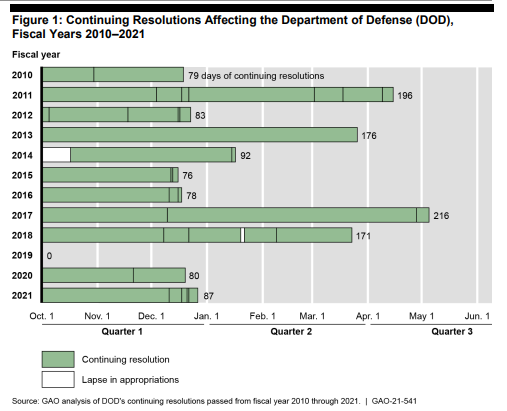Don’t Fear the CR
In what is becoming an almost annual tradition, it’s unlikely that Congress will have completed its already postponed annual appropriations work by the new December 3rd deadline, making it necessary to enact another continuing resolution (CR) to avoid a government shutdown during the holiday season. CRs are far from ideal policy making, but neither are they the catastrophe that some fear.
Passing an annual budget and subsequent appropriations bills is the central role of Congress, enshrined in Article 1 Section 8 of the Constitution, and often referred to as the Power of the Purse. It is the primary means by which Congress can hold the other two branches of government in check and exert effective oversight. Punting on these vital decisions via a CR—which, as the name suggests, continues programmatic spending at the current levels give or take some anomalies until a future date—can leave significant swaths of the federal ledger unexamined, at least for the time being.
This is problematic, but appropriations aren’t the only oversight and accountability tools at Congress’s disposal. Congress has investigative authority, resolutions of disapproval, war powers, nominations, a watchdog agency, inspectors general, and a host of other means both institutional and political that all play a role in maintaining Congress’s First Branch perch.
Predictably, the biggest opposition comes from those who claim that a CR undermines our national security. DefenseNews.com has a good sampling of this autumnal lament featuring officials across different branches of the military warning about delays in hiring and New Start procurement, disruption and compromised readiness. The national security think tank sphere, in turn, reliably echoes these concerns.
But a recent report from the Government Accountability Office (GAO)—the aforementioned congressional watchdog agency—makes a strong case that the yearly hand-wringing is overblown. The FY 2020 National Defense Authorization Act required the GAO to “review the effects of CRs on the DOD [Department of Defense]” and what the GAO found was DOD has become good at operating under a CR. This is good news, particularly when you consider that with the exception of 2019, for the past 10 years the fiscal year was well underway before regular appropriations were enacted. In fact, for 60 years the fiscal new year has kicked off with a CR the vast majority of the time and so far, the sky has not fallen.

The GAO explains that while a standard provision of CRs does prohibit “New Starts,” which are new programs or activities not funded in the previous fiscal year including increased production rates or initiating advance procurement, programs GAO reviewed, “were able to avoid delays and cost increases during the fiscal years affected by a CR.”
Further, “While these restrictions have the potential to cause delays and cost increases to major defense acquisition programs, our analysis of selected acquisition programs did not find any instances where this occurred.”
How was this miracle on the Potomac accomplished? GAO found three big reasons DOD can weather a CR:
Not every defense dollar is equal, depending on the account there can be a big difference in how many years those funds are available. Operations and maintenance and military personnel funds are one year dollars. Research, Development, Test and Evaluation account dollars are good for two years. Procurement: three years. Military Construction: five years. The GAO found that the “DOD’s major acquisition programs are funded through Research, Development, Test and Evaluation and Procurement appropriations, both of which are multi-year amounts.”
Military services have learned to live with CRs and have adapted their business practices accordingly. The GAO found “no examples of CRS negatively affecting training or readiness.” This was achieved by shifting contract start dates, certain purchases and training until later in the fiscal year.
Expect the worst. GAO reports that, “(…) activities related to preparing for and operating under CRs have become routine in nature and are an expected part of [the DOD’s] annual planning and budget-related tasks.”
This kind of preparedness is exactly what should be expected from an agency vested with the awesome responsibility of maintaining our national security and it should be reassuring to everyone that the DOD can take these funding frustrations in stride.
Sen. Patrick Leahy (D-Vt.) sets up another CR strawman, claiming that a CR is a “major cut” to defense. As is often the case in Washington, the Senate Appropriations chair is confusing level funding for reduced funding, much like the 2011 Budget Control Act’s slightly-less-generous-than-originally-projected caps were considered “draconian.” The Senator’s logic is that because his own party-approved legislation would increase DOD funding by 5 percent, or $37 billion, maintaining DOD funding at FY 2021 levels, a mere $688.06 billion, somehow constitutes a “major cut.”
In FY 2021 the United States was still engaged in a major conflict in Afghanistan with a significant troop and materiel presence. This is no longer the case. A CR at last year’s funding is more than adequate to continue to fund our current national security needs. It would be unfortunate if lawmakers ignored this opportunity to secure real, much-needed savings and finally reduce DOD overspending.
Lawmakers continue to suggest against all evidence more really is less and that CRs threaten our security. This is not the case, and now we have reliable information that confirms these worries are unfounded. A CR just means more of the same. We shouldn’t be so ready to dismiss that when there are worse options.







